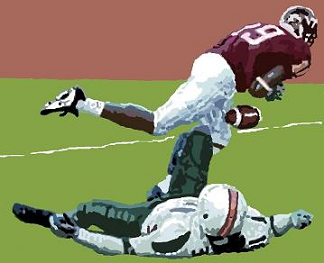1) Miami (FL) 12-0
2) Oregon 11-1
3) Florida 10-2
4) Tennessee 11-2
5) Texas 11-2
6) Oklahoma 11-2
7) Louisiana State 10-3
8) Nebraska 11-2
9) Colorado 10-3
10) Washington State 10-2
11) Maryland 10-2
12) Illinois 10-2
13) South Carolina 9-3
14) Syracuse 10-3
15) Florida State 8-4
16) Stanford 9-3
17) Louisville 11-2
18) Virginia Tech 8-4
19) Washington 8-4
20) Michigan 8-4
21) Boston College 8-4
22) Georgia 8-4
23) Toledo 10-2
24) Georgia Tech 8-5
25) Brigham Young 12-2
This was a tough one, and I've spent more time on it than on any of the others thus far. Teams were highly erratic in 2001, and in the end there probably isn't much difference between any of the teams ranked #5 to #25.
Take #19 Washington (8-4). They lost to #1 Miami 65-7 and to unranked UCLA 35-13. Yet they also defeated #16 Stanford 42-28 and #10 Washington State 26-14. They lost to unranked Oregon State 49-24, but beat #20 Michigan 23-18.
Then there's the mess at the top of the Big 12. You could logically rank any of that league's top 4 teams higher than the other three, depending on what you want to focus on. Yet it all seemed so simple heading into the Thanksgiving Holiday. 11-0 Nebraska had beaten 10-1 Oklahoma 20-10, who had beaten 9-1 Texas 14-3, who had beaten 8-2 Colorado 41-7. Pretty easy to rate that foursome.
But then Colorado beat Nebraska 62-36, and all hell broke loose. The national championship race at the end was by far the wildest and strangest of the BCS era, topping the similarly wild 2007 finish as well as the 2003 #2 vs. #3 absurdity. And we'll not see a stranger one...

Miami's perfect season was preserved in their last game of the regular season when Virginia Tech's Ernest Wilford dropped a 2-point conversion pass attempt at the end of the game, leaving eventual national champion Miami a 26-24 winner.
